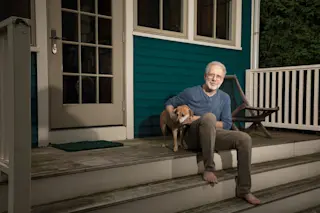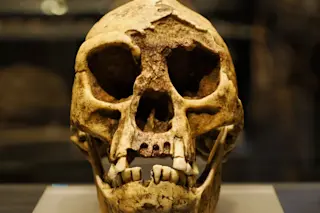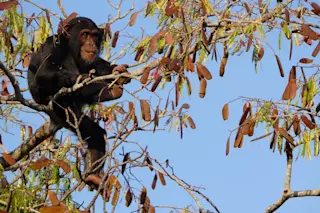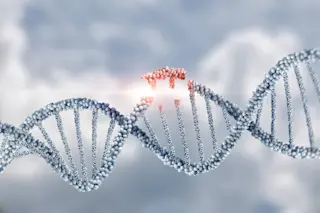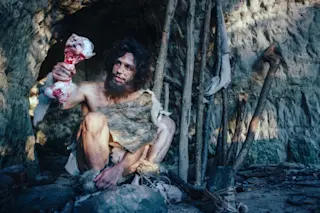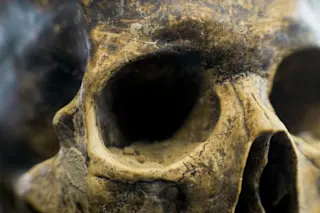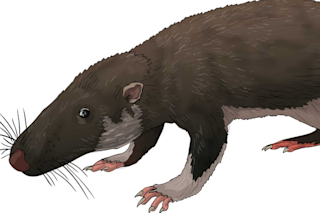This story was originally published in our Nov/Dec 2022 issue as "On Foot." Click here to subscribe to read more stories like this one.
Going places on foot isn’t a particularly glamorous way to get around. Sure, there are proven health, social and environmental benefits. But walking is … well, pedestrian, and for many running is a chore — or something you do when you’re late to catch a bus.
According to human evolutionary biologist Daniel Lieberman, though, those activities are central to understanding what makes us human. When our ancestors adapted to getting around on two limbs instead of four, that adjustment made its mark on nearly every part of the human body from head to toe (and even our butts).
Lieberman and his team at the Harvard University Skeletal Biology and Biomechanics Lab use evidence from the fossil record, biomechanics experiments in the lab and field research to develop models that explain the evolution of human physical activity. He has written two books on the subject for a general audience: The Story of the Human Body in 2014 and Exercised in 2021.
Lieberman was nicknamed “the barefoot professor” after his 2010 study in Nature suggested that running barefoot or in minimally padded footwear — the way our ancestors did — typically results in a runner landing on their forefoot, which may protect the foot from high-impact injuries. An avid runner himself (he’s run the Boston Marathon 11 times), he personally has been running in minimalist footwear for years.
More recently, Lieberman’s research continues to investigate the consequences of the modern, post-industrial lifestyle being out of step with how humans evolved to be physically active — an idea he explores in Exercised.
Discover talked to Lieberman about how walking and running helped shape the human body, the pros and cons of shoes, and what evolution can teach us about staying fit and healthy in the modern world.
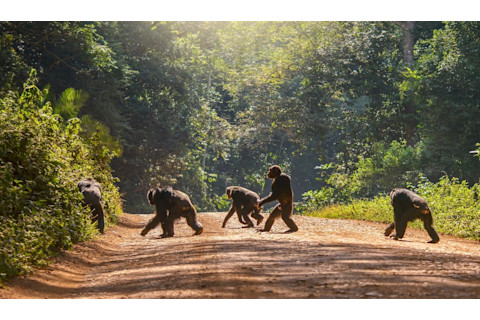
Knuckle walkers expend twice as much energy as humans, who adapted to save energy by standing upright (Credit: Cherylramalho/Dreamstime).
Cherylramalho/Dreamstime
Q: Why look at walking and running from an evolutionary biology perspective?
It's clear that the initial cause that made the human lineage go on a different path from our ape cousins was bipedalism. We have evidence that probably around 7 million years ago, when we split off from the chimpanzee lineage, our very earliest ancestors were bipeds of some sort. If you want to understand human evolution, walking on two legs is critical. We wouldn't be here, and we wouldn't be the way we are, if we hadn't been walkers and then also runners.
Q: How did our ancestors become bipeds?
Our last common ancestor with chimpanzees was probably pretty much like a chimpanzee; it was a knuckle-walker. The thing about knuckle-walking is that it's really an [energy-]expensive way to walk. It's great if you want to have really long arms and climb trees but still be able to walk around on the ground. But if you put a chimpanzee on a treadmill and you put an oxygen mask on it — which students of mine have done — you actually find out the chimpanzee spends twice as much energy to walk a given distance for a given unit of mass than a human being.
When we split from the chimpanzee lineage, it was during a time when the rainforests in Africa were sort of breaking up and the environment was becoming more and more open. So imagine, 7 million years ago, you’ve got some little group of our chimpanzee-like ancestors, and all of a sudden the forest is gone. And now they're in a woodland habitat and have to travel about twice as far every day to get food. If you can save energy by standing upright, then obviously, natural selection is going to favor that. If you can spend less energy on walking around, you can spend more on having babies. It's very hard to know exactly what the first bipeds were like, but by 4 million years ago, they were pretty good bipeds.
Q: When did they pick up running?
Around 2 million years ago, the Ice Age started. And that's when the big grasslands started opening up and all of a sudden, our foods were kind of disappearing. But there's another source of food out there, which is animals. Our ancestors didn't have any serious technology. All they had was clubs and rocks. So the way in which we think they hunted and scavenged was by running.
But instead of running really fast, we became good at endurance, because with two legs you can’t go very fast compared to most mammals. We were able to run long distances in the middle of the day when it was hot, chase animals down, and drive them to exhaustion. Today, of course, you can go to a supermarket and buy meat wrapped in cellophane, but back in the day, running was critically important.
Q: How do we know so much about physical activity from millions of years ago?
We have fossil and other evidence. So we can look at the anatomical structures that make us good at walking and running and analyze them. For running, we have mechanisms to stabilize the head. We have shoulders and hips that can move and rotate independently from the legs and the head so that we can rotate our bodies properly. We have arches in our feet that store up energy like springs. We have long tendons in our legs, like the Achilles, that act like springs. We have short toes, which don't matter when you're walking, but boy do they matter when you're running.
My favorite one is the gluteus maximus. Its upper portion is vastly expanded in humans compared to chimpanzees because it stabilizes our upper bodies when we run. It turns on with every step, preventing the upper body from pitching forward. We can see in the fossil record when butts get big. The insertion of the upper portion of the gluteus maximus leaves a scar on the pelvis.
We then figure out how to test the biomechanics of the differences that we see. For example, we stuck electrodes on people's butts, and watched how the gluteus maximus functions.
And we go to the field and we study people in places where they don't have access to the kind of modern technology and machines that we do, to see how they use their bodies and how we can use that to interpret and analyze evolutionary record — but also to look at what happens when we shift to the kind of modern world in which we live, where people don’t walk as much.
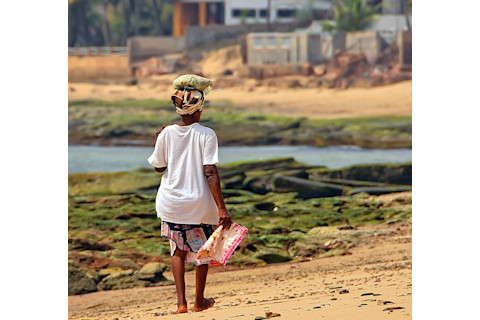
For millions or even billions of people in the world, Lieberman says, walking barefoot is the norm — and their feet are healthier for it (Credit: Nataly Reinch/Shutterstock).
Nataly Reinch/Shutterstock
Q: How does looking at living people in the lab and in the field tell you about human ancestors?
A traditional way of doing this kind of research was to look at a fossil and compare that fossil to different living species. If it looks like a human, well, it must have behaved like a human. If it looks like a chimpanzee or a gorilla, it must behave like a chimpanzee or a gorilla. That's an OK way of doing science, but we can do a little bit better today.
For example, Lucy, the famous australopith [a primate ancestor to modern humans; Lucy’s species, Australopithecus afarensis, lived in Africa about 3 million years ago], has pretty long toes. And chimpanzees have long toes. So it was inferred that since Lucy has long toes and chimpanzees have long toes, and chimpanzees don't walk very well, Lucy probably couldn't walk very well. But that was just an inference.
So [to test it] we did a study on toe length. Together with graduate student Campbell Rolian, we built a model to figure out as your toes get longer how much force would be produced in the toe joint. We could therefore figure out how much force Lucy would have produced when walking. And the answer is that Lucy could have done just fine walking, but she would have been in trouble running long distances.
Q: Speaking of running, when did shoes come onto the scene?
Nobody really knows when shoes were invented. Because shoes don't fossilize. They don't [easily] preserve in the archaeological record. I would say most anthropologists would bet that by about 40 to 50 thousand years ago, shoes were common to some extent, because that's when we first see the evidence for tailoring.
But it wasn't like all of a sudden, we started wearing shoes. We started wearing shoes more frequently for certain things in certain cultures. In the ancient Olympics, nobody competed with shoes. It was unheard of. You would run barefoot. And there's still millions, maybe billions of people in the world today who are still barefoot. We shouldn't generalize from Western European-American culture to the rest of the world. That doesn't work.
Q: Has the widespread adoption of wearing shoes changed us as a species?
I don't know of any evidence that there's been natural selection as a result of shoes. Because after all, there are still a lot of people on the planet who are not wearing shoes. And they're doing just fine. In fact, in many ways, they're doing better than the rest of us.
Q: What are the pros and cons of shoes?
Shoes are comfortable. They protect your feet from heat and cold and from things that would puncture you. And they can also sometimes reduce how much work your foot muscles have to do. But they also come with a cost. The foot is loaded with an incredible number of diverse sensory nerves that provide detailed information to our brain and our central nervous system about what's going on. And when you wear shoes, you lose a lot of that information. So there’s a trade-off.
We published a paper in Nature a few years ago, showing that calluses don't involve that trade-off. We went to look at folks in [Kenya] who never wear shoes and have thick calluses — normal by human evolutionary standards. And we poked their feet with special little sensors to measure how sensitive their feet were to different kinds of frequencies and pressures. They could feel everything just as well as people with thin calluses.
Q: So is being barefoot better?
I've studied thousands of the feet of barefoot people. And I can tell you, in general, they're much nicer than the feet of shod people. I mean, sometimes they're a little dirty, but they don't smell. Athlete's foot is a modern problem. I don't think anybody gets athlete's foot in the barefoot world.
But more importantly, people who are barefoot tend to have really healthy feet in terms of strength. About a third of Americans have flat feet. In the barefoot populations that we study, almost nobody has flat feet. We think it is possible either that children don't develop an arch properly if they're wearing shoes too early in life, or as grown-ups get older and bigger and heavier, [the arches] just collapse.
There may be a lot of advantages to minimal footwear and I think they need to be explored more. But we tend to oversimplify these things. I don't think simple prescriptions ever work. If you're a Westerner who's used to the support of cushioned shoes, and you suddenly transition to minimal footwear, you’d better do it gradually and slowly and learn how to run properly or you’re going to hurt yourself. I would say that you should adapt your shoe to the kind of running that you do.
Q: What else have you learned from cultures who live barefoot?
One thing that we're learning is just how important walking is for health. Walking is the most fundamental form of physical activity. And the more we study this, the more we realize how important walking and other forms of physical activity are for slowing the process of senescence, for maintaining health as you age.
[In the developed world] we're able to suddenly stop being physically active, often for much of our lives, and we pay a big price for that. In small-scale societies, people don't stop being physically active when they become grandparents. There’s no retirement — retirement is a very modern concept. They’re foraging and they're hunting and they're working in the field. And that keeps them physically active as they get older. And in turn, that physical activity helps them stay healthy as they age. It's a feedback mechanism.
Physical activity is profoundly important for human health. Walking and running and jumping, swimming, whatever it is, you want to do whatever form of locomotion you like. It's just critical that we keep moving and so whether you're wearing shoes are not or doesn't matter — just move.


